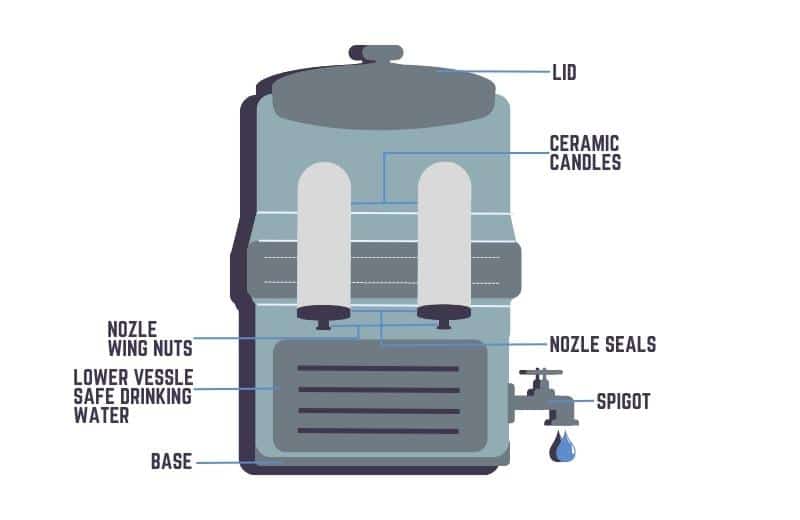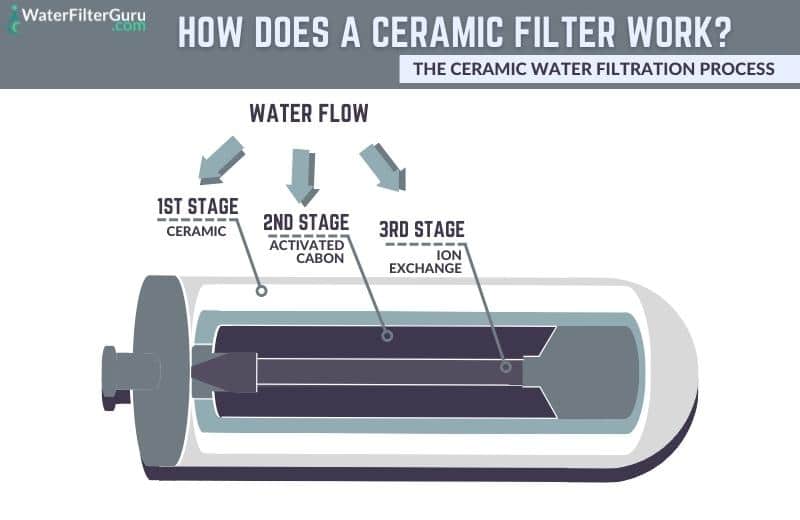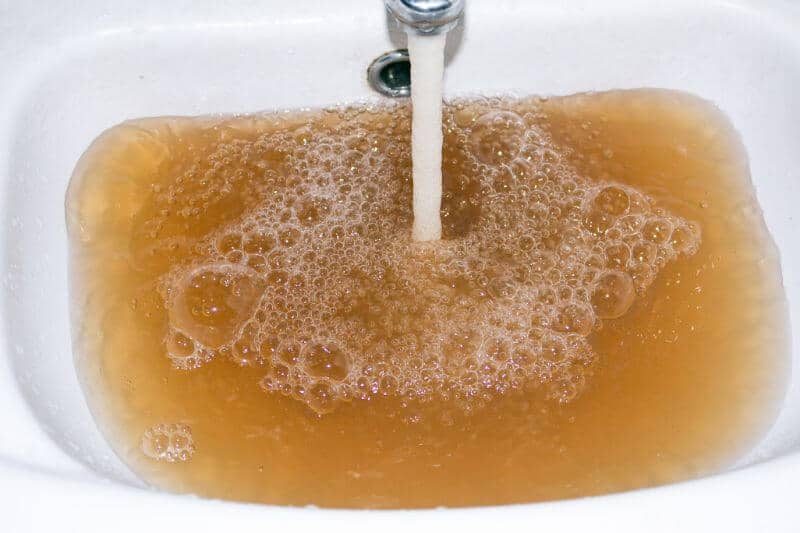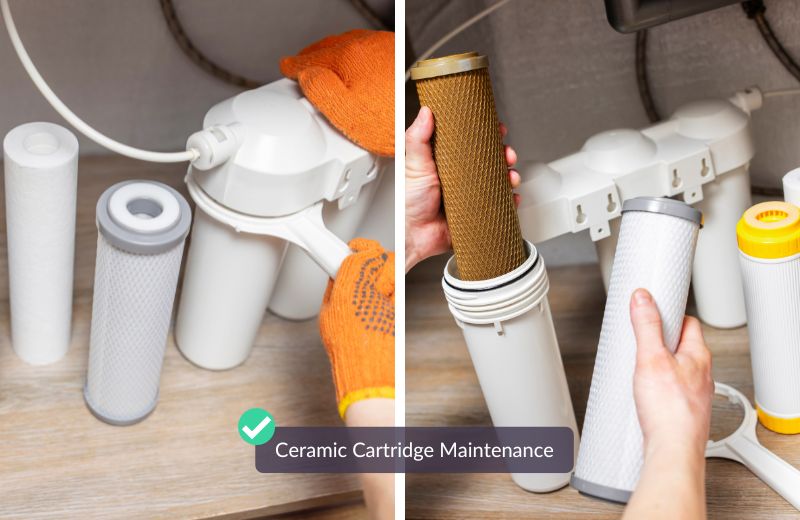Considering a ceramic filter for your home? Wondering how this water filter is made, what it removes, or where it’s installed?
We’ve got you covered with this guide, which answers all your questions about ceramic filters. By the end, you’ll be enough of an expert to decide whether this type of filter is suitable for your needs.
Table of Contents
- ❔ What is a Ceramic Water Filter?
- 💰 How Much do Ceramic Filters Cost?
- 📤 How do Ceramic Water Filters Work?
- ✅ What does a Ceramic Water Filter Remove?
- ⛔️ What Doesn’t a Ceramic Drinking Water Filter Remove?
- 🤔 When Should you Use a Ceramic Water Filter?
- 🪛 Ceramic Water Filter Maintenance
- 🧠 Ceramic Water Filter FAQs
❔ What is a Ceramic Water Filter?
A ceramic water filter is a cartridge filter that features a ceramic surface containing millions of tiny pores. This type of water filtration is versatile and affordable, with multiple use types in at-home and portable filter devices.
A ceramic filter cartridge, or ceramic filter candle, sits on top of a plastic or ceramic receptacle. This filter sends water through a series of pores, with twists and turns that trap contaminants as water passes through.
Ceramic water filters can be found in countertop, under-sink, gravity-fed, and portable filtration systems. Occasionally, these filters are found in whole-house or commercial water treatment units.
Ceramic water filtration is one of the oldest filtration methods, invented in the early 1800s. The popularity of ceramic filtration today is a testament to its effectiveness in treating specific drinking water contaminants.

What Are Ceramic Filter Candles?
In your research, you may have seen “ceramic filter candles” included in certain ceramic filter systems available today.
Sometimes, this term is just another way to describe a ceramic filter. Most of the time, however, it refers to a ceramic filter that has been combined with another filtration media, such as activated carbon. Using activated carbon at the core of a ceramic filter increases the media’s adsorption abilities.
Some ceramic filters are combined with ion exchange media, which targets an additional set of contaminants: heavy metals.
The best ceramic filters are laced with silver, which prevents pathogenic bacteria, mold, and algae from forming on the filter media. This is especially important for ceramic filters, because they can be washed and reused, so they last longer than other filters (creating more opportunities for bacteria buildup).
💰 How Much do Ceramic Filters Cost?
Ceramic water filters are an affordable, great-value investment. The cost of a ceramic filter depends on the type of system you buy:
| System Type | Average Cost |
|---|---|
| Point of Use Filter (Countertop or Under-Sink ) | $100-$500 |
| Portable Filter | $30-$120 |
| Whole House System | $350-$1,000 |
Regardless of the type of ceramic filter system you buy, you’re guaranteed to save money compared to buying bottled water to exclusively drink throughout the year. You can clean and reuse these filters, reducing the frequency of replacement filters needed. These filters don’t need electricity or backwashing, so they won’t increase your electricity or water bill.
📤 How do Ceramic Water Filters Work?
Ceramic water filters have millions of half-micron pores in their casing. When water flows through these pores, any contaminants larger than half a micron are trapped in the pores and are unable to pass through to the other side.
To encourage the most thorough filtration, the inside of a ceramic filter is a maze of twists, turns, and right angles. Any contaminants that make it past the surface of the media become trapped as they’re carried through the media in the water.
This process mimics the natural water purification process in the earth, in which water seeps through the layers of rock and soil, and is filtered along the way.
The small pore sizes and complexity of a ceramic filter enable it to remove much smaller contaminants than other filters, such as bacteria.

✅ What does a Ceramic Water Filter Remove?
Some of the contaminants that ceramic filters are known to remove are:
- Bacteria, protozoans, microbial cysts, and some viruses. Ceramic filters are some of the only filter cartridges to have small enough pores to remove pathogens like bacteria, cysts, and protozoans. Some viruses are also removed by ceramic filtration, but many viruses are small enough to slip through the ceramic media.
- Sediment. Particulates like dust, rust, dirt, debris, and sand are all filtered by a ceramic water filter. The bonus of a ceramic water filter system is that it can be flushed, so sediment build-up doesn’t mean the end of the filter.
- Turbidity. Suspended particles in the water that turn the water brown or yellow can be removed by a ceramic water filter system. You can use a ceramic filtration cartridge to restore water to a clear state.
Ceramic filters combined with activated carbon are capable of removing additional contaminants in water, including chlorine and volatile organic compounds. Consider buying a ceramic filter combined with carbon if your water comes from a public supply.
Ceramic filters combined with ion exchange can also remove heavy metals from water, like lead, zinc, copper, and mercury.

⛔️ What Doesn’t a Ceramic Drinking Water Filter Remove?
Certain contaminants can’t be removed by ceramic filtered water systems:
- Total dissolved solids, or TDS. Don’t expect a ceramic filtration system to remove all dissolved solids from your drinking water. These filters are capable of filtering water, not purifying it.
- Viruses. While a ceramic drinking water filter removes some viruses from contaminated water, some are small enough to slip through the pores.
- Minerals. Ceramic filters aren’t the same as water softeners, and they can’t remove healthy minerals or minerals that contribute to water hardness, like calcium and magnesium.
🤔 When Should you Use a Ceramic Water Filter?
You should consider using ceramic filters if:
You Need a Reliable Portable Filter
Portable ceramic filters are ideal for hiking and camping trips, or for off grid living. If you plan to be off the grid and won’t have access to clean, safe drinking water, take a ceramic portable filter with you. The ceramic membrane will trap the likes of algae and protozoans, and you can flush the filter to get rid of any dirt and sediment buildup.
You Want a Long-Lasting POU Filter
Ceramic under-sink and countertop filters have a lifespan of between six and 12 months, depending on the cartridge size. You can extend your filter’s lifespan by flushing it – sending water in the opposite direction through the filter.
You Have Well Water
Ceramic filtering cartridges are ideal for well water as they’re capable of removing bacteria and sediment – both commonly found in private well supplies. If you want to get your well water filtered by an affordable household water treatment system that can reliably remove contaminants that may be in your water, buying a system with a ceramic element should do the job.

Your Space is Limited
Ceramic water filters are space-saving, so they’re a good option for anywhere where space is limited, like RVs and apartments. Gravity-fed models, such as a countertop unit, can be stored out of the way when they’re not in use.
🪛 Ceramic Water Filter Maintenance
The two main maintenance tasks involved in owning ceramic filters are cleaning and replacing the filter.
Cleaning the Filter
A huge benefit of this type of filter is that, unlike most other water filters, it can be cleaned several times over. The ability to flush the filter and remove contaminant buildup on the media means you can get longer out of the filter before it needs to be replaced.
To clean the filter, follow these steps:
- Remove the filter from the housing, being as gentle as possible – ceramic candle-type filters have a fragile exterior surface that’s prone to cracking.
- Submerge the filter in a bowl of water and use a soft scouring pad, toothbrush, or plastic brush to clean it. You just need plain water – don’t use soaps or detergents, as they may permanently damage the filter.
Note: scrub away from the threaded mount or cover the mount with plastic to prevent contamination. - Check that the washer on the sealing is correctly in place, then install the filter back in the housing.
Replacing the Filter
After around six to 12 months of use, the ceramic candle will need to be replaced. The exact process of replacing the filter depends on the type of system you have, but the general steps are listed below.
- Remove the filter from the housing and place it to the side to dispose of later.
- Unwrap the new filter from its packaging and follow the manufacturer’s instructions for flushing or soaking the filter before use.
- Install the new filter into the filter housing. The filter is now ready for use.

🧠 Ceramic Water Filter FAQs
How long do ceramic water filters last?
The best ceramic water filter cartridges last for up to three years, and some commercial ceramic filters last longer than this. However, the exact lifespan of the filter depends on how regularly it is cleaned, and what else the filter might contain. For instance, if your filter contains carbon, even flushing the ceramic pores won’t help, as carbon media is exhausted faster than ceramic media. On average, you’ll need to replace your filter every 6-12 months. Check your user manual to be sure.
Can you recycle ceramic filters?
Not usually, but some manufacturers offer filter recycling programs that incentivize you to send your filters back to them for discounted future filter purchases. You could also compost your filter.
Are ceramic water filters effective?
Yes – although it depends on what you want to remove. To achieve the best quality filtered water from this type of filter, find one that combines ceramic media with carbon or KDF. This will be effective in removing chlorine, metals, bacteria, and sediment from your source water.
Does a ceramic filtering cartridge affect flow rate?
Generally, no. Your water flow rate shouldn’t be compromised by installing a ceramic candle filter. However, your flow rate will begin to slow as your filtration system becomes clogged with dirty water impurities. Regularly flushing the filter will ensure fast delivery of your filtered water. This is especially important if you have a countertop system that uses gravity filtration.

